Abstract
The vertical-takeoff–horizontal-landing (VTHL) two-stage-to-orbit (TSTO) system is a kind of novel launch vehicle in which a reusable first stage can take off vertically like a rocket and land horizontally like an airplane. The advantage of the VTHL TSTO vehicle is that the launch costs can be reduced significantly due to its reusable first stage. This paper presents an application of multidisciplinary analysis optimization on preliminary sizing in conceptual design of the VTHL TSTO vehicle. The VTHL TSTO concept is evaluated by multidisciplinary analysis, including geometry, propulsion, aerodynamics, mass, trajectory, and static stability. The preliminary sizing of the VTHL TSTO vehicle is formulated as a multidisciplinary optimization problem. The focus of this paper is to investigate the impacts of the first-stage reusability and propellant selection on the staging altitude and velocity, size, and mass of the VTHL TSTO vehicles. The observations from the results show that the velocity and altitude of the optimal staging point are determined mainly by the reusability of the first stage, which in turn affects the size and mass of the upper stage and the first stage. The first stage powered by hydrocarbon fuel has a lower dry mass compared with that powered by liquid hydrogen.
1. Introduction
Small satellites are expected to take an increasing share of the space market [1]. To reduce the launch cost of the small satellites, reusable launch vehicles (RLVs) have drawn significant attention. One kind of RLV is the two-stage-to-orbit launch vehicle with a reusable first stage (booster stage). Generally, there are three concepts for the reusable first stage of the TSTO RLVs: vertical takeoff–vertical landing (VTVL), vertical takeoff–horizontal landing (VTHL), and horizontal takeoff–horizontal landing (HTHL) [2]. The VTVL concept has been applied to the Falcon 9 of company SpaceX, and its effectiveness is now well established [3]. However, the VTVL concept requires additional rocket propellant during the ascent phase to perform boost-back and landing burns [4], resulting in energy waste and reduced payload capacity [5]. In contrast, the VTHL concept uses wings of the first stage for gliding back and landing, thereby eliminating the propellant for boost-back and landing. The HTHL concept has the advantage of fast turn-around operations, but it has more technological complexity and challenges.
The VTHL concept might be considered a near-term option for the future TSTO RLVs due to fewer technology risks compared to the HTHL concept. The VTHL concepts were investigated by the U.S. Air Force’s project of ARES (Affordable Responsive Spacelift) [6,7] and the U.S. DARPA’s Experimental Spaceplane Program (XSP, previously XS-1) [8]. In the XSP conceptual design, the reusable first stage has an airplane-like configuration, and the upper stage is expendable with payload into orbit, as shown in Figure 1. Both the first stage and the upper stage are powered by rockets. The study [8] indicated that no critical new technology was needed to develop the XSP design. In Europe, the VTHL and VTVL concepts were compared in the project of European Next Reusable Ariane (ENTERAIN) [9]. The VTHL system of ENTERAIN adopts a tandem configuration, and its first stage returns to the launch site through In-Air Capturing [10], as shown in Figure 2. The study from the ENTERAIN project shows that the VTHL concept has a lower gross lift-off weight (GLOW) for the same payload capacity.
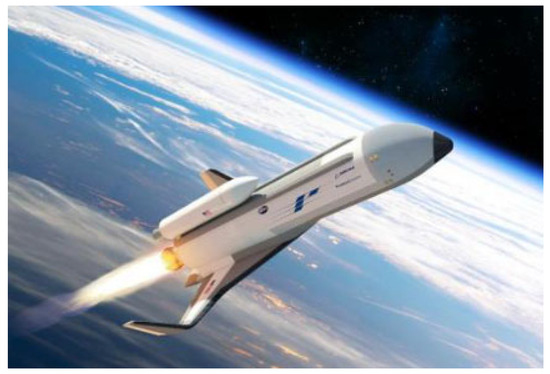
Figure 1.
Boeing’s XS-1 Phase I concept [8].
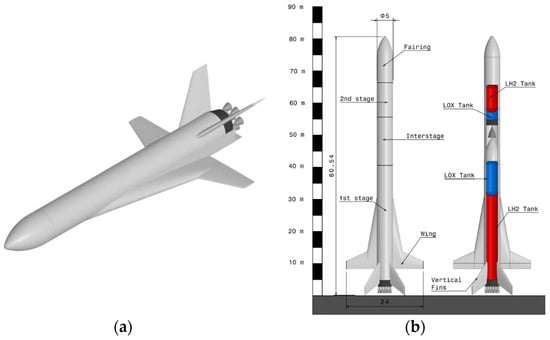
Figure 2.
VTHL concept in ENTRAIN [9]: (a) the reusable first stage and (b) the whole system.
Preliminary sizing is one of the major tasks in conceptual design of aerospace vehicles. Its task is to estimate the vehicle’s overall size and volume, thrust required, gross mass, propellant mass, dry mass, etc., based on the vehicle’s mission requirements.
The preliminary sizing of the VTHL TSTO launch vehicle is a relatively new issue due to the novelty of this kind of vehicle. For fast iterations in the preliminary sizing, empirical/semi-empirical methods and rapid analysis methods are often used on a scalable configuration to estimate the convergent size and mass. Simon et al. [11] presented a sizing activity for the TSTO launch vehicles by using the hypersonic convergence method and solution space generation process. The code HySIDE [12] is a vehicle sizing tool consisting of several analysis modules, such as mass, propulsion, trajectory, etc. By using the code HySIDE, Hank et al. [12] estimated the gross mass, dry mass, wetted area, and volume required for the TSTO reusable launch vehicles. Kothari et al. [13] used the HySIDE to analyze and compare various launch vehicle concepts, including VTHL and HTHL configurations. More recently, multidisciplinary analysis optimization (MDAO) or multidisciplinary design optimization (MDO) has been considered as a more effective method for preliminary sizing of novel vehicles, and it has been widely applied in preliminary sizing of the aircraft [14,15], VTVL vehicle [16,17,18], re-entry vehicle [19], etc. Brevault et al. [20] developed a multi-level MDO formulation for the VTHL concepts and presented the trade-off assessment between glide-back and fly-back concepts using the MDO method.
In this study, we apply MDAO to the preliminary sizing in the conceptual design of VTHL TSTO vehicles. The purpose of this study is to (1) develop a preliminary sizing tool for the VTHL TSTO vehicles; and (2) investigate the impacts of the first-stage reusability (number of reuses) and propellant selection on the size, mass, altitude and velocity at staging point, and lift-off thrust of a notional VTHL TSTO vehicle. It is expected that the sizing tool and the observations from this study will assist the conceptual design of the VTHL TSTO vehicle.
The remainder of this paper is organized as follows. A notional concept of the VTHL TSTO vehicle is described in Section 2 and is used as a baseline design. The multidisciplinary analysis method for the baseline vehicle is presented in Section 3. The preliminary sizing for the VTHL TSTO vehicle is formulated as an optimization problem in Section 4. The optimization results and discussions are presented in Section 5. The paper ends with observations from this study in Section 6.
2. The Notional Concept of the VTHL TSTO Vehicle
The configuration of the VTHL TSTO in this study is shown in Figure 3, in which the expendable upper stage is positioned parallel to the reusable first stage. Both the first stage and the upper stage are powered by rockets. The function of the first stage is to carry the upper stage to the staging point where the upper stage is separated from the first stage. The function of the upper stage is to deliver the payload into low Earth orbit (LEO). The first stage has an airplane-like configuration with the following features: (1) low wing for easy arrangement of landing gear; (2) double delta wing for reduction of wave drag; (3) two wingtip-mounted vertical tails to provide sufficient clearance for placement of the upper stage; and (4) elevons on the wings and rudders on the vertical tails to provide pitch and yaw control.
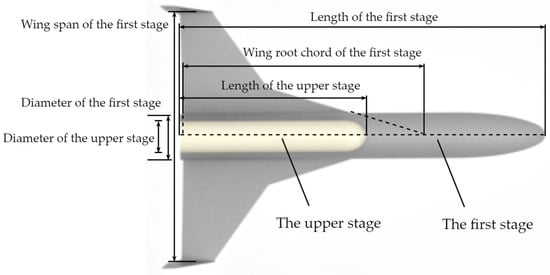
Figure 3.
Configuration of the notional VTHL TSTO concept.
With reference to the XSP program [8], the mission of the VTHL TSTO vehicle is to deliver a 1360 kg payload into a circular orbit at 200 km height, and the staging point is initially set at an altitude of 50 km and a Mach number (Ma) of 8. The mission profile is illustrated in Figure 4. The first-stage takeoff is performed vertically, like a rocket. When the first stage ascends to the staging point, the upper stage is separated from the first stage. After that, the upper stage ignites its engine and ascends to the low Earth orbit at a speed of 7900 m/s, and then it delivers the payload to the orbit. Meanwhile, the first stage glides back to the launch site and lands horizontally at an airport.
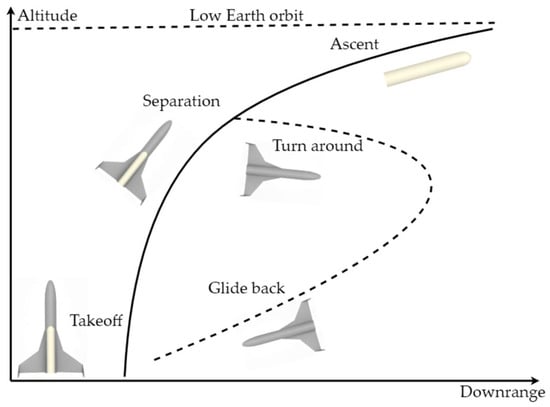
Figure 4.
Mission profile of the notional VTHL TSTO concept.
Initial values of the overall geometric parameters of the notional VTHL TSTO concept are assumed with reference to [5] and are listed in Table 1.

Table 1.
Overall geometric parameters.
3. Multidisciplinary Analysis Method
The VTHL TSTO vehicle needs to be evaluated to verify whether it is able to complete the mission defined in Figure 4. Since the vehicle consists of the first stage and the upper stage, each stage needs to be evaluated through multidisciplinary analysis (MDA). The evaluation process for the entire vehicle (first stage + upper stage) is shown in Figure 5, where the mass of the upper stage can be considered the payload of the first stage. According to the vehicle’s mission profile and configuration, the evaluation of the upper stage is conducted first, followed by the evaluation of the first stage.
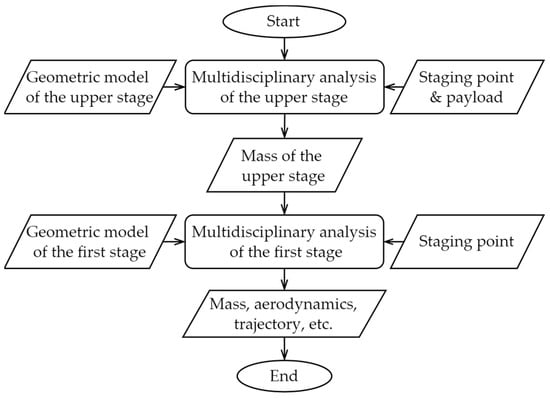
Figure 5.
Flowchart for evaluation of the VTHL TSTO vehicle.
The evaluation of the vehicle is multidisciplinary in nature. The multidisciplinary analysis architecture of the first stage is shown in Figure 6, in which several modules of disciplines such as propulsion, geometry, aerodynamics, mass, trajectory, and static stability are included. All of those disciplines are needed for the evaluation of the first-stage design and are integrated according to the relationships between them. For example, the mass estimation needs data from the geometry module, nozzle area ratio from propulsion module, and fuel mass estimated by trajectory module. On the other hand, the inputs of the trajectory module are the gross mass from the mass module, lift and drag from the aerodynamics module, and specific impulse from the propulsion module. Therefore, there exists a coupling between the mass and trajectory modules.
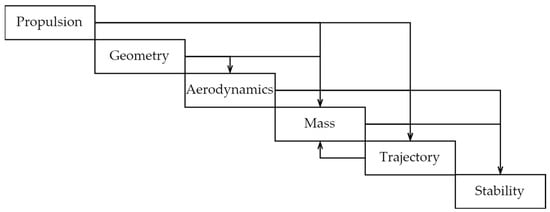
Figure 6.
Multidisciplinary analysis architecture of the first stage.
Integration of all of the above modules into the single code of multidisciplinary analysis is implemented in MATLAB R2021a. Each module is called by batch commands and is encapsulated as MATLAB functions. A specific MAT file in MATLAB is used as the data container that saves the outputs from the modules. Each module receives the required input data from the MAT file.
The multidisciplinary analysis framework of the upper stage is similar to that of the first stage, except that the stability module is excluded. The following subsections describe the functions and methods for each module in brief.
3.1. Geometry
The function of the geometry module is to create a 3D model of the vehicle and calculate the geometric features (such as the wetted area, reference area, etc.) of the vehicle. The output from the geometry module is used for aerodynamics and mass estimations.
The 3D model of the vehicle is generated using a parametric modeling method. The first stage consists of the fuselage, wing, and vertical tail. The fuselage is defined by its diameter, length, and cross-sections. The double delta wing consists of an inner wing and an outer wing. The planform of the inner and outer wings is defined by the taper ratio, span, root chord, and dihedral, respectively. The planform of the vertical tail is defined by its span, root chord, and tip chord. The airfoils of the wing and the vertical tail are defined by the NACA airfoils. The overall parameters of the upper stage are the diameter and length. The nose shapes of the upper stage and the first stage are predefined considering aerodynamics and heat flux.
Once the geometric parameters have been defined, a 3D geometric model of the vehicle can be generated automatically in CATIA by use of the Visual Basic script code. An example of the three-dimensional geometric model generated by the Visual Basic script code is shown in Figure 7 using American projection.
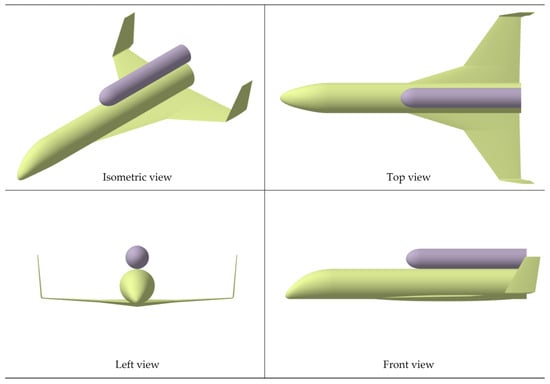
Figure 7.
Three-dimensional model generated by the geometry module.
3.2. Propulsion
The propulsion module estimates the specific impulse of the rocket engine when given its technical parameters, such as chamber pressure, nozzle area ratio, etc. The impacts of different propellants on thrust and impulse can be analyzed as well.
The Chemical Equilibrium Analysis (CEA) code [21], developed by NASA, is used to estimate the specific impulse of rocket engines. The CEA code calculates the theoretical performance of rockets based on the assumption of chemical equilibrium in the combustion products. Given the propellants (e.g., liquid hydrogen/liquid oxygen and methane/liquid oxygen) and engine’s technical parameters, the CEA program calculates the characteristic velocity and coefficient of thrust at different altitudes, which are then used to calculate the specific impulse.
The estimation of specific impulse needs parameters of chamber pressure and nozzle area ratio. The unit of the impulse is second, and the unit of chamber pressure is MPa. The nozzle area ratio is dimensionless. In this study, liquid hydrogen (LH2), kerosene (RP1), and methane (CH4) are used for the first stage while the upper stage use LH2 only. Thus, there are four engine cases with different propellants that need to be estimated. The engine’s technical parameters are assumed as follows [21]: the chamber pressure is 12 MPa, and the nozzle area ratios for the upper stage and the first stage are 12 and 75, respectively. Then, the rocket engine performances are presented in Table 2, in which Isp,vac denotes the specific impulse in vacuum, and Isp,sl represents the specific impulse at sea level.

Table 2.
Rocket engine performances.
3.3. Aerodynamics
The aerodynamic module calculates the lift, drag, and moment of the vehicle and creates an aerodynamic database for the trajectory module.
The aerodynamic database contains aerodynamic coefficients of the entire flight envelope, from subsonic to hypersonic. The U.S. 1976 standard atmosphere model [22] is used, assuming no wind. The aerodynamic analysis methods suitable for the conceptual design of the notional vehicle are used in this study, as shown in Table 3.
Since the upper stage operates at higher altitudes and hypersonic speeds (Ma > 5), the local surface inclination method [23] is used to rapidly calculate its aerodynamic coefficients, and the reference temperature method [24] is used for viscous corrections.
For the entire vehicle and the first stage, their flight speed ranges from subsonic to hypersonic. Their aerodynamic performance is computed using an in-house inviscid CFD package [25]. This in-house inviscid CFD package uses a finite volume Euler method on adaptive Cartesian grids that is similar to the method of Cart3D [26] and is suitable for the flow field analysis of the vehicle with a wide speed range from subsonic to hypersonic. The viscous corrections are added to the computation results from the inviscid CFD package. When the Ma is less than 3, the semi-empirical method [27] is used to predict the viscous drag. When the Ma exceeds 3, the reference temperature method [24] is used instead.

Table 3.
Aerodynamic analysis methods.
Table 3.
Aerodynamic analysis methods.
| Vehicle | Ma | Inviscid | Viscous Correction |
|---|---|---|---|
| The upper stage | >6 | Local surface inclination method [23] | Reference temperature method [24] |
| The entire vehicle/the first stage | 0~3 | Finite volume Euler method [25] | Semi-empirical method [27] |
| The entire vehicle/the first stage | >3 | Finite volume Euler method [25] | Reference temperature method [24] |
Although the rapid aerodynamic methods are used in this study, the creation of the aerodynamic database for the wide speed range still results in a considerable computational cost. Moreover, the vehicle geometry will be updated in optimization process, and aerodynamic analysis for each updated geometry is needed, leading to very large computation costs. To address this issue, surrogate modeling methods are used to reduce the aerodynamic computation cost for different geometries of the vehicles. Using this aerodynamic surrogate model, the vehicle’s lift, drag, and moment coefficients can be quickly calculated when the geometric parameters, flight velocities, and altitudes are given.
Basically, surrogate modeling consists of three steps: (1) sampling in design space by use of design of experiments (DOE), (2) obtaining performance of the vehicle for the samples through numeric simulations, and (3) training the surrogate model. In this study, Optimal Latin Hypercube Sampling is used for the design of experiments, and Artificial Neural Network is used for the surrogate model. A comprehensive review of surrogate modeling can be found in Reference [28].
3.4. Mass
The mass module estimates the gross mass and center of gravity (c.g.) of the vehicle according to data from the modules of the geometry, propulsion, and trajectory. The estimated mass will be used in the trajectory module, and the center of gravity will be used in the stability module. The mass breakdown for both stages is shown in Figure 8.
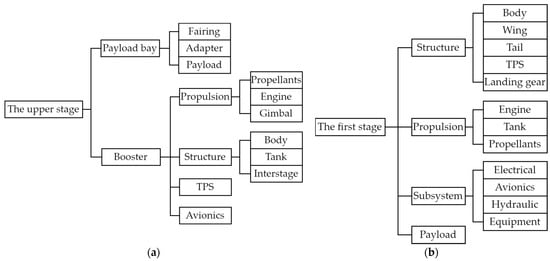
Figure 8.
Mass breakdown for the vehicle: (a) the upper stage and (b) the first stage.
The masses of the structure, tanks, engines, avionics, and other components of the upper stage are estimated using the mass estimation relationships (MERs) [29,30]. For cryogenic propellants, the additional temperature-control systems are considered in mass estimations of tanks. Thus, the masses of tanks are different for different propellants.
The masses of the body, wings, landing gear, subsystems, thermal protection system (TPS), etc., of the first stage are estimated by HASA method [31]. In this method, estimations for the component masses are obtained based on statistical data. The mass estimation equations for the major components are given as follows:
where Wb is the body mass (lb); Ww is the wing mass (lb); Wfinv is the vertical tail mass (lb); Wgear is the landing gear mass (lb); Sbtot is the body wetted surface area (ft2); Lb is the body length (ft); Dbe is the equivalent body diameter (ft); Qmax is the maximum dynamic pressure(lb/ft2); mf is the modifying factor (1.12 for aluminum, 2.0 for titanium); ULF is the ultimate load factor (usually 3.75 or 5.25); Wemp is the empty mass (lb); Sref is the reference wing area (ft2); AR is the wing aspect ratio; is the wing taper ratio; t/c is the wing-thickness-to-chord ratio; is the mid-chord sweep angle; Swfv is the vertical stabilizer planform area (ft2); and Wgtot is the total gross mass (lb).
The masses of the engine and propellant tanks of the first stage are estimated using the MERs of the rocket engine [30]. During the return phase of the first stage, its flight speed might be over Ma 5 at relative low altitude. Thus, a thermal protection system (TPS) is needed for the first stage. The TPS mass of the first stage is estimated by the HASA method [31], given a specific thermal protection material. The properties of the thermal protection materials can be obtained from Reference [32], and the thickness of the TPS is estimated by solving a one-dimensional transient heat equation [33].
The center of gravity of the fuselage, wings, landing gear, subsystems, etc., is estimated by the empirical method [34], and the center of gravity of the propellant tanks, engine, etc., is estimated according to Reference [16].
3.5. Trajectory
The trajectory module computes the required propellant masses for both the upper stage and the first stage according to the mission requirements, engine performance, aerodynamic characteristics, and mass.
Three-degree-of-freedom (3DOF) motion equations are used to simulate the trajectory of the vehicle. The required propellant mass of the vehicle is computed by a trajectory optimization method, in which the objective of the trajectory optimization is to minimize the required propellant mass for the upper stage and the first stage. In this study, the program GPOPS [35] is used to solve the trajectory optimization problem. GPOPS is based on the hp-adaptive pseudospectral method, which can solve optimal control problems quickly. After the trajectory optimization, the required propellant mass for the specified mission requirements is obtained.
According to the mass, the lift, and the drag at landing, the approach velocity and landing distance of the first stage can be estimated by an engineering method [36] that is used for landing-performance calculations for civil aircraft.
3.6. Stability
During the fly-back phase of the first stage, the first stage should be stable. Ideally, the stability analysis should include static and dynamic stability, as well as control requirements. But dynamic stability analysis is complex for any acceptable accuracy. To reduce computational burden in the preliminary sizing phase, dynamics stability and control analysis are not included in this study. The dynamic stability and control analysis will be included in the MDAO framework for subsequent design phase after the preliminary sizing. On another hand, for conventional aircraft configurations, satisfaction of static stability requirements will probably give acceptable dynamic stability [37]. Under those considerations in this study, only static stability is evaluated in the stability module. The stability module calculates the static stability of the first stage at typical speeds during the fly-back phase.
The static stability of the first stage is assessed by the following Equation (2):
where Cm is the pitching-moment coefficient with respect to the c.g., CL is the lift coefficient, Cn is the directional moment coefficient, Cl is the rolling moment coefficient, and β is the sideslip angle. Those aerodynamic coefficients are calculated by the aerodynamic module. The c.g. is computed by the mass module.
4. Optimization Formulation for Preliminary Sizing of the Notional Vehicle
The task of preliminary sizing in this study is to estimate the size, mass, staging altitude and velocity, and lift-off thrust of the notional VTHL TSTO vehicle for the given mission. This sizing problem can be formulated as a multidisciplinary optimization problem with an objective, design variables, and constraints.
4.1. Objective
The VTHL TSTO concept should be sized such that the cost per launch of the payload is minimal. The objective function of the optimization should reflect the launch cost. In general, the cost of the launch vehicle is closely related to its mass. Reference [29] indicates that the cost of propellant is relatively small in total launch costs, while the dry mass of the vehicle (the gross mass minus the masses of propellant and payload) is a dominant contributor to the launch cost. For example, the propellant mass of the Atlas V rocket accounts for over 90% of the gross mass, but its cost accounts for only 1% of the total launch cost. Therefore, minimization of the dry mass is more reasonable than minimization of the gross mass of the vehicle.
In this study, we use the expendable dry mass (i.e., dry mass consumed per launch) as a figure of merit. The objective in the optimization is to minimize the expendable dry mass. Since the first stage of the vehicle is reusable, its dry mass can be spread over a number of flights [17]. Under this consideration, the objective function can be expressed as follows:
where EM is the expendable dry mass of the entire vehicle, EM1 is the dry mass of the upper stage, EM2 is the dry mass of the first stage, and n is the number of reuses of the first stage. From Equation (3), one can see that the value of the objective function will be changed with different number of reuses of the first stage, thus impacting the optimal solution. For simplicity, in this study, it is assumed that the mass penalties and refurbishment costs with the reuse cycles of the first stage are relatively a small portion of the cost per launch, and influences of the reuse number on mass penalties and refurbishment costs are ignored.
EM = EM1 + EM2/n
4.2. Design Variables
The vehicle’s overall geometric parameters, which represent the size of the vehicle, have a large influence on its dry mass, aerodynamic characteristics, volume, and static stability. The altitude and velocity at the staging point have a large effect on the ascent trajectory and the propellant mass distribution between the two stages. The lift-off thrust-to-weight ratio for the first stage is typically between 1.2 and 1.5, and there exists an optimal lift-off thrust of the first stage for a minimal EM.
From the above considerations, the design variables in the optimization include the overall geometric parameters of the vehicle, the altitude and velocity at the staging, and the lift-off thrust of the first stage. The design variables are listed in Table 4, in which the bounds for the design variables are set based on the baseline concept in Section 1.

Table 4.
Design variables.
4.3. Constraints
In the conceptual design of the TSTO VTHL vehicle, several key constraints should be considered, including constraints of the volume, trajectory, landing distance, and static stability.
In terms of the volume constraint, the sizes of both stages (the upper stage and the first stage) must meet requirements for accommodation of the payload, tanks, and engines. Both stages consist of components such as the fairing, payload bay, forward skirt, tanks, inter-tank section, and aft skirt. The lengths of those components can be estimated using the method from Reference [29] when their diameters are specified. To meet the volume constraint, the length available defined by the design variables must be larger than the length required (i.e., sum of the lengths of the components). The length margin is defined as the value of the length available minus the length required, and it must be larger than 0 to meet the volume constraint.
The trajectory constraint ensures that the payload can be delivered to the orbit at a specified velocity. The specified altitude and velocity at the orbit are set as terminal constraints of the trajectory of the upper stage.
The landing distance constraint ensures that the first stage is capable of landing at a common airport. In computation of the landing distance, the angle of attack of the first stage at landing is assumed to be 8°.
The static stability of the first stage during the return phase is assessed under typical flight conditions (i.e., Ma = 0.8, 1.2, 2, and 6, with an angle of attack of 6°).
All the constraints are listed specifically in Table 5.

Table 5.
Constraints for optimization.
4.4. Procedure for the Optimization
The multidisciplinary optimization problem defined in the previous sections is solved by the procedure illustrated in Figure 9. The flowchart is based on the principles of extended design structure matrix (XDSM) [38]. In Figure 9, x(0) is the initial design variables; x*, f*, and c* are the optimal variables, objective, and constraints; x1 and x2 are the design variables of the upper stage and the first stage, respectively; and y1 and y2 are the outputs of disciplines of the upper stage and the first stage, respectively. The thin black lines show the process flow, while the thick gray lines show the data flow.
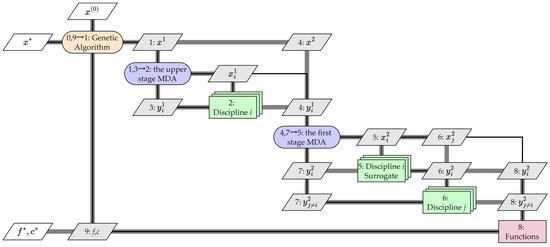
Figure 9.
Flowchart of the optimization procedure.
For the vehicle defined by the design variables, a multidisciplinary analysis for the upper stage is conducted. The mass of the upper stage is estimated and is used as the payload for the first stage. Then, a multidisciplinary analysis for the first stage is followed. Among the disciplines in Section 3, the aerodynamics and stability model are replaced by a surrogate model to reduce the computational cost. After that, the objective and constraints of the optimization are calculated.
Considering that the objective and constraint functions may be discontinuous due to the multidisciplinary nature of the research, the optimization problem defined above is a non-smooth optimization problem.
The genetic algorithm is used to find the solution to this non-smooth optimization problem.
In this study, we use the open-source genetic algorithm code [39] to solve the optimization problem. Design variables are binary-coded. Both the objective and constraints are considered in the fitness calculation. Driven by the genetic algorithm, the design variables are updated according to the operators of selection, crossover, and mutation. This process is iterated continuously until convergence is achieved. In this genetic algorithm, binary crossover and polynomial mutation are used. The probability of crossover is set to 1, and the expectation of the number of mutated variables is set to 1. Elitism from the previous generation will be preserved in the next generation. Based on statistical tests performed beforehand, it is appropriate that the population size is set to 200 and the maximum iteration is set to 100. The tests show that the convergence can be achieved.
Generally, each optimization is convergent within around 10 h on a workstation with an I7-14700K CPU.
5. Results and Discussions
Using the multidisciplinary analysis and optimization method presented in Section 3 and Section 4, we investigate the impacts of the first stage’s reusability and propellant selection on the preliminary sizing of the notional TSTO VTHL vehicle.
5.1. Impacts of the First Stage’s Reusability on Sizing of the Vehicle
The reusability of the first stage has a large effect on the value of the objective function, as defined in Section 4.1. Considering that the first stage of the Falcon 9 has been reused more than 10 times without major refurbishment [40], three cases are considered in this study:
- Case 1: The first stage is used only once.
- Case 2: The first stage is reused 5 times.
- Case 3: The first stage is reused 10 times.
In all three cases, the propellants for both stages are assumed to be liquid hydrogen/liquid oxygen (LH2/LOX).
After optimization, the lift-to-drag ratios of the entire vehicle at Ma = 8 for the three cases are shown in Figure 10, where Case 1 has a lower lift-to-drag ratio due to its smaller wing. The ascent trajectories for the three cases are shown in Figure 11. It can be seen that the requirement to deliver the payload to LEO is satisfied for all three cases. In the final stage of the launch trajectory, the engine is off for a while, and the second stage just slides into the target orbit. Thus, the velocity decreases slightly while the altitude increases. The landing distance of the first stage for the three cases is 1769 m, 1799 m, and 1797 m, respectively. The constraint for the landing distance is satisfied, which means that these cases, after optimization, can land on regular airfields. Also, static stability constraints are satisfied for all three cases.
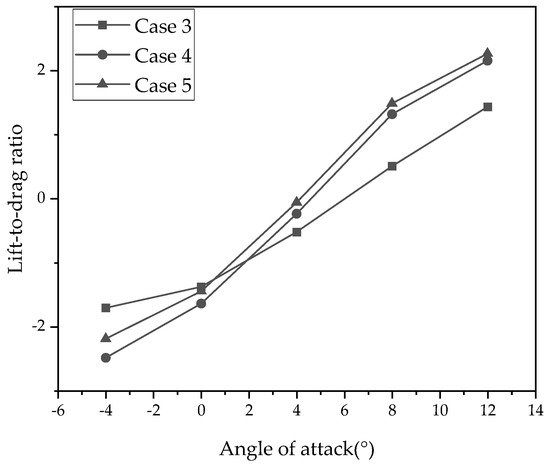
Figure 10.
Lift-to-drag ratio of the entire vehicle of the three cases after optimization.
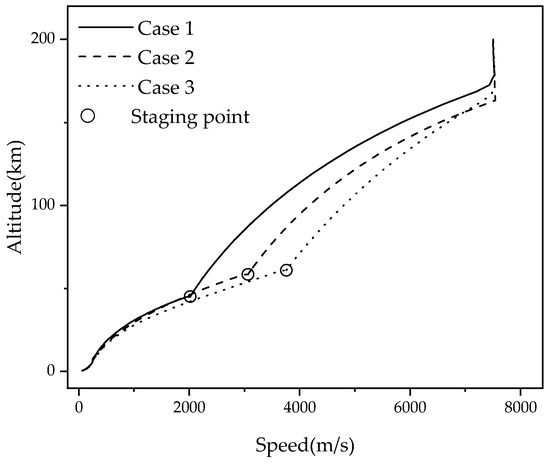
Figure 11.
Trajectory profile of the three cases after optimization.
The optimal values of the design variables are given in Table 6, and the masses of the vehicle after the optimization are given in Table 7. From those tables, it can be seen that increasing the number of reuses of the first stage leads to the following results:

Table 6.
Values of the design variables for three cases after optimization.

Table 7.
Masses for the three cases after optimization.
- (1)
- The dry mass and size of the upper-stage decrease;
- (2)
- The dry mass, fuselage size, and wing size of the first stage increase;
- (3)
- The velocity and altitude at the staging point increase;
- (4)
- The propellant fraction for the upper stage decreases, and the propellant fraction of the first stage increases;
- (5)
- The lift-off thrust of the first stage increases.
The optimization results of the three cases seem to suggest that the increase in the reuse number of the first stage leads to an increase in the staging altitude and velocity, consequently leading to the increases in the mass, size, and lift-off thrust of the first stage, and decreases in the mass and size of the upper stage.
However, since the upper stage must accommodate the payload, the minimum size of the upper stage is limited. In addition, the lift-off thrust of the first-stage engine is limited by current technology available. In this study, it is assumed that the diameter of the upper stage is not less than 1.6 m, and the thrust of the first stage cannot exceed 1400 kN (as seen Table 4). Considering those limitations, we further investigate the impact of the reuse numbers of the first stage on the optimal staging velocity and altitude. With the ideal assumption that the first stage can be reused many times, Figure 12 shows the optimal staging velocity and altitude with the reuse numbers, in which the reuse number extends to 40. From Figure 12, it can be seen that the staging altitude and velocity will not increase any more when the reuse number reaches a certain value. The reason is that there are limitations of the minimum size of the upper stage and the available lift-off thrust of the first stage.
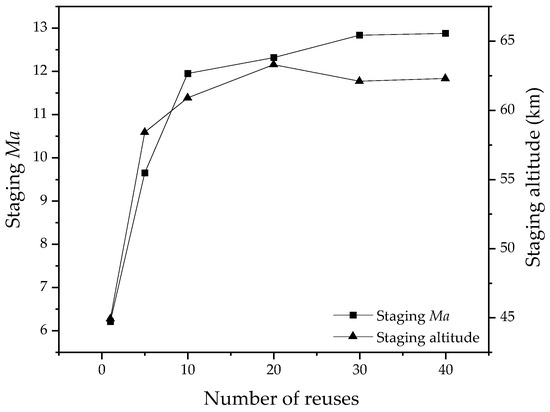
Figure 12.
Optimal staging Ma and altitude with the number of reuses.
5.2. Impacts of Propellant Selection on Sizing of the Vehicle
The propellant selection is an important issue in conceptual design of the vehicle. Liquid hydrogen (LH2) has a high specific impulse and is clean, but it suffers from low density and requires cryogenic storage. In contrast, kerosene offers high density, easier storage, and proven reliability; however, it has a lower specific impulse and leads to carbon deposition. Methane presents a balanced performance: medium specific impulse and density, less carbon deposition, and soft-cryogenic temperature [41].
In this study, we investigate the impacts of propellant selection on the sizes and masses of the notional vehicle. For comparison, two cases are considered:
- Case 4: The propellant of the first stage is kerosene.
- Case 5: The propellant of the first stage is methane.
In both cases, the propellant of the upper stage is liquid hydrogen, and the reuse number of the first stage is set as 10.
After optimization, the lift-to-drag ratios of the entire vehicle at a subsonic speed (Ma = 0.8) and a hypersonic speed (Ma = 6) for Cases 3, 4, and 5 are shown in Figure 13. Static stability constraints defined by Equation (2) are all satisfied. Table 8 presents the static stability at the typical subsonic and hypersonic speeds.
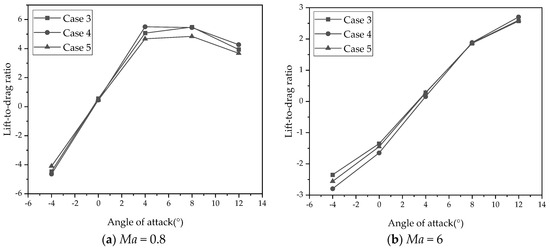
Figure 13.
Lift-to-drag ratio of the entire vehicle of Cases 3, 4, and 5 after optimization: (a) Ma = 0.8; (b) Ma = 6.

Table 8.
Static stability for Cases 3, 4, and 5 after optimization.
Table 9 and Table 10 show the optimization results for Case 4 and Case 5. In these tables, the results for Case 3 from the previous section are also included for comparison. In Case 3, the propellant of the first stage is liquid hydrogen, and the reuse number of the first stage is 10.

Table 9.
Values of design variables for Cases 3, 4, and 5 after optimization.

Table 10.
Masses for Cases 3, 4, and 5 after optimization.
As observed from Table 9 and Table 10, Case 3, i.e., the selection of liquid hydrogen as propellant for the first stage, results in a lower gross mass and a lower lift-off thrust for the entire vehicle due to higher specific impulse of liquid hydrogen. However, the lower density of liquid hydrogen leads to increases in the size of the first stage and the mass of the fuel tanks. Compared to Case 4 (kerosene) and Case 5 (methane), Case 3 (LH2) has a higher expendable dry mass, resulting in a higher launch cost. Due to the high density of kerosene, Case 4 has the lowest expendable dry mass despite the highest gross mass. It is suggested that the selection of kerosene as propellant in the reusable first stage has the lowest launch cost due to kerosene having the lowest expendable dry mass. Case 5 has comparable gross mass and dry mass compared to Case 4, suggesting methane as a viable alternative.
6. Conclusions and Future Work
In this paper, we present an application of multidisciplinary analysis optimization (MDAO) to preliminary sizing in conceptual design of the TSTO VTHL vehicle. The focus of this paper is to investigate the impacts of the first-stage reusability and propellant selection on the staging altitude and velocity, size, mass, and lift-off thrust of the vehicle.
Based on the optimization results of the notional TSTO VTHL vehicle, the following points can be concluded:
- (1)
- The reusability (number of reuses) of the first stage has a significant impact on the staging altitude and velocity. The increase in the reuse number usually leads to an increase in the staging altitude and velocity, consequently leading to the increases in the mass, size, and lift-off thrust of the first stage, and decreases in mass and size of the upper stage. However, if the limitations of the upper stage size and the available lift-off thrust of the first stage are considered, the staging altitude and velocity will not increase any more with the increase in the reuse number when the reuse number reaches a certain value.
- (2)
- Compared to the use of liquid hydrogen for the first stage, the use of hydrocarbon propellants has less expendable dry mass, resulting in a reduction of launch cost.
This study indicates that the launch cost, as an objective of the optimization, has a significant impact on preliminary sizing of the TSTO VTHL vehicle. The following issues need further investigation to ensure more realistic applications:
- (1)
- To improve the practicality of the MDAO method for configuration selection and preliminary sizing of the vehicle, it is suggested that a more refined launch cost model for the TSTO VTHL vehicle should be developed in future research. The cost model should consider mass penalties, refurbishment costs, or performance degradation associated with the reuse cycles. Also, engine complexity and overall system cost for different propellants should be considered in the refined cost model.
- (2)
- The fatigue strength requirements under repeated use may influence the structural mass of the first stage.
- (3)
- To improve robustness of the optimization results, the uncertainties in the mass, aerodynamics, and engine estimation models should be considered. This will lead to the study on preliminary sizing of the TSTO VTHL vehicle using uncertainty-based multidisciplinary analysis and optimization.
Author Contributions
Conceptualization, X.X., X.F. and X.Y.; methodology, X.X.; software, X.X.; validation, X.X. and X.Y.; formal analysis, X.X.; investigation, X.X. and X.F.; resources, X.X.; data curation, X.X.; writing—original draft preparation, X.X.; writing—review and editing, X.X. and X.Y.; visualization, X.X.; supervision, X.Y.; project administration, X.Y.; funding acquisition, X.Y. All authors have read and agreed to the published version of the manuscript.
Funding
This research was funded by Transdisciplinary Innovation Fund of Nanjing University of Aeronautics and Astronautics, grant number KXKCXJJ202407.
Data Availability Statement
The data presented in this study are available from the corresponding author upon request.
Conflicts of Interest
The authors declare no conflicts of interest.
Abbreviations
| GLOW | Gross lift-off weight |
| HTHL | Horizontal takeoff–horizontal landing |
| LEO | Low earth orbit |
| MDA | Multidisciplinary analysis |
| MDO | Multidisciplinary optimization |
| MDAO | Multidisciplinary analysis optimization |
| MER | Mass estimation relationship |
| RLV | Reusable launch vehicle |
| TPS | Thermal protection system |
| TSTO | Two-stage-to-orbit |
| VTVL | Vertical takeoff–vertical landing |
| VTHL | Vertical takeoff–horizontal landing |
| XDSM | Extended design structure matrix |
| Notations | |
| β | Sideslip angle |
| Wing taper ratio | |
| Mid-chord sweep angle | |
| c.g. | Center of gravity |
| CL | Lift coefficient |
| Cl | Rolling moment coefficient |
| Cm | Pitching moment coefficient |
| Cn | Directional moment coefficient |
| Dbe | Equivalent body diameter |
| EM | Expendable dry mass |
| Isp,sl | The specific impulse at sea level |
| Isp,vac | The specific impulse in vacuum |
| Lb | Body length |
| Ma | Mach number |
| Qmax | Maximum dynamic pressure |
| Sbtot | Body wetted surface area |
| Sref | Reference wing area |
| Swfv | Vertical stabilizer planform area |
| t/c | Wing thickness to chord ratio |
| Wb | Body mass |
| Ww | Wing mass |
| Wfinv | Vertical tail mass |
| Wgear | Landing gear mass |
| Wgtot | Total gross mass |
References
- Maddock, C.A.; Ricciardi, L.; West, M.; West, J.; Kontis, K.; Rengarajan, S.; Evans, D.; Milne, A.; McIntyre, S. Conceptual Design Analysis for a Two-Stage-to-Orbit Semi-Reusable Launch System for Small Satellites. Acta Astronaut. 2018, 152, 782–792. [Google Scholar] [CrossRef]
- Dissel, A.F.; Kothari, A.P.; Lewis, M.J. Comparison of Horizontally and Vertically Launched Airbreathing and Rocket Vehicles. J. Spacecr. Rocket. 2006, 43, 161–169. [Google Scholar] [CrossRef]
- Seedhouse, E. Falcon 9 and falcon heavy. In SpaceX: Starship to Mars—The first 20 Years; Springer International Publishing: Cham, Switzerland, 2022; pp. 71–93. [Google Scholar]
- Brendel, E.; Hérissé, B.; Bourgeois, E. Optimal Guidance for Toss Back Concepts of Reusable Launch Vehicles. In Proceedings of the 8th European Conference for Aeronautics and Aerospace Sciences, Madrid, Spain, 31 July 2019. [Google Scholar]
- Balesdent, M.; Brevault, L. Multidisciplinary Design and Optimization of Winged Architectures for Reusable Launch Vehicles. Acta Astronaut. 2023, 211, 97–115. [Google Scholar] [CrossRef]
- Adams, J.; Hampsten, K.; Hickman, R. ARES: Affordable Responsive Spacelift—The U. S. Air Force’s Next Generation Launch System. In Proceedings of the Space 2005, Long Beach, CA, USA, 30 August–1 September 2005. [Google Scholar]
- Quashne, M.; Cunningham, T.; Sibal, A. Affordable Responsive Spacelift Vehicle Payload Placement Stability Analysis. In Proceedings of the 46th AIAA Aerospace Sciences Meeting and Exhibit, Reno, NV, USA, 7–10 January 2008. [Google Scholar]
- Wierzbanowski, S.; Ramasubramanian, V. The DARPA Experimental Spaceplane Program (XSP): Observations, Findings, and Recommendations for Future Reusable Launch Systems. In Proceedings of the ASCEND 2020, Virtual, 16–18 November 2020. [Google Scholar]
- Stappert, S.; Wilken, J. European next Reusable Ariane (ENTRAIN): A Multidisciplinary Study on a VTVL and a VTHL Booster Stage. In Proceedings of the 70th International Astronautical Congress, Washington, DC, USA, 21–25 October 2019. [Google Scholar]
- Sippel, M.; Bussler, L.; Krause, S.; Cain, S.; Stappert, S. Bringing Highly Efficient RLV-Return Mode “In-Air-Capturing” to Reality. In Proceedings of the HiSST: International Conference on High-Speed Vehicle Science Technology, Moscow, Russia, 26–29 November 2018. [Google Scholar]
- Simon, S.; Chudoba, B. Conceptual Design and Sizing Study of Reusable TSTO Launch System. In Proceedings of the ASCEND 2021, Las Vegas, NV, USA, 15–17 November 2021. [Google Scholar]
- Hank, J.; Franke, M.; Eklund, D. TSTO Reusable Launch Vehicles Using Airbreathing Propulsion. In Proceedings of the 42nd AIAA/ASME/SAE/ASEE Joint Propulsion Conference & Exhibit, Sacramento, CA, USA, 9–12 July 2006. [Google Scholar]
- Kothari, A.; Livingston, J.; Tarpley, C.; Raghavan, V.; Bowcutt, K.; Smith, T. Rocket Based Combined Cycle Hypersonic Vehicle Design for Orbital Access. In Proceedings of the 17th AIAA International Space Planes and Hypersonic Systems and Technologies Conference, San Francisco, CA, USA, 11–14 April 2011. [Google Scholar]
- Ciampa, P.D.; Nagel, B. AGILE Paradigm: The next Generation Collaborative MDO for the Development of Aeronautical Systems. Prog. Aerosp. Sci. 2020, 119, 100643. [Google Scholar] [CrossRef]
- Hosseini, S.; Vaziry-Zanjany, M.A.; Ovesy, H.R. A Framework for Aircraft Conceptual Design and Multidisciplinary Optimization. Aerospace 2024, 11, 273. [Google Scholar] [CrossRef]
- Castellini, F. Multidisciplinary Design Optimization for Expendable Launch Vehicles. Ph.D. Thesis, Politecnico di Milano, Milano, Italy, 2012. [Google Scholar]
- Dresia, K.; Jentzsch, S.; Waxenegger-Wilfing, G.; Santos Hahn, R.D.; Deeken, J.; Oschwald, M.; Mota, F. Multidisciplinary Design Optimization of Reusable Launch Vehicles for Different Propellants and Objectives. J. Spacecr. Rocket. 2021, 58, 1017–1029. [Google Scholar] [CrossRef]
- Musso, G.; Figueiras, I.; Goubel, H.; Gonçalves, A.; Costa, A.L.; Ferreira, B.; Azeitona, L.; Barata, S.; Souza, A.; Afonso, F.; et al. A Multidisciplinary Optimization Framework for Ecodesign of Reusable Microsatellite Launchers. Aerospace 2024, 11, 126. [Google Scholar] [CrossRef]
- Viviani, A.; Aprovitola, A.; Iuspa, L.; Pezzella, G. Aeroshape Design of Reusable Re-Entry Vehicles by Multidisciplinary Optimization and Computational Fluid Dynamics. Aerosp. Sci. Technol. 2020, 105, 106029. [Google Scholar] [CrossRef]
- Brevault, L.; Balesdent, M.; Hebbal, A.; Patureau De Mirand, A. Surrogate Model-Based Multi-Objective MDO Approach for Partially Reusable Launch Vehicle Design. In Proceedings of the AIAA SciTech 2019 Forum, San Diego, CA, USA, 7–11 January 2019. [Google Scholar]
- McBride, B.J.; Gordon, S. Computer Program for Calculation of Complex Chemical Equilibrium Compositions and Applications II. Users Manual and Program Description; Report NASA-RP-1311; NASA: Washington, DC, USA, 1996. [Google Scholar]
- United States Committee on Extension to the Standard Atmosphere. U.S. Standard Atmosphere; National Oceanic and Atmospheric Administration, NASA, United States Air Force: Washington, DC, USA, 1976. [Google Scholar]
- Anderson, J.D. Hypersonic and High Temperature Gas Dynamics; American Institute of Aeronautics and Astronautics: Reston, VA, USA, 2000. [Google Scholar]
- Eckert, E.R.G. Engineering Relations for Heat Transfer and Friction in High-Velocity Laminar and Turbulent Boundary-Layer Flow Over Surfaces with Constant Pressure and Temperature. J. Fluids Eng. 1956, 78, 1273–1283. [Google Scholar] [CrossRef]
- Lyu, F.; Li, Z.; Deng, J.; Xiao, T.; Yu, X.Q. An Aerodynamic Analysis Tool for Aircraft Conceptual Design at Full Speed Range. Acta Aerodyn. Sin. 2017, 35, 625–632. (In Chinese) [Google Scholar]
- Aftosmis, M.; Berger, M.; Adomavicius, G. A Parallel Multilevel Method for Adaptively Refined Cartesian Grids with Embedded Boundaries. In Proceedings of the 38th Aerospace Sciences Meeting and Exhibit, Reno, NV, USA, 10–13 January 2000. [Google Scholar]
- Cummings, R.M.; Mason, W.H.; Morton, S.A.; McDaniel, D.R. Applied Computational Aerodynamics: A Modern Engineering Approach; Cambridge University Press: Cambridge, UK, 2015. [Google Scholar]
- Yondo, R.; Andrés, E.; Valero, E. A Review on Design of Experiments and Surrogate Models in Aircraft Real-Time and Many-Query Aerodynamic Analyses. Prog. Aerosp. Sci. 2018, 96, 23–61. [Google Scholar] [CrossRef]
- Edberg, D.; Costa, W. Design of Rockets and Space Launch Vehicles; American Institute of Aeronautics and Astronautics: Reston, VA, USA, 2020. [Google Scholar]
- Akin, D.L. Mass Estimating Relations. 2016. Available online: https://spacecraft.ssl.umd.edu/academics/791S16/791S16L08.MERsx.pdf (accessed on 14 January 2025).
- Harloff, G.J.; Berkowitz, B.M. HASA-Hypersonic Aerospace Sizing Analysis for the Preliminary Design of Aerospace Vehicles; Report NASA-CR-182226; NASA: Washington, DC, USA, 1988. [Google Scholar]
- Williams, S.D.; Curry, D.M. Thermal Protection Materials: Thermophysical Property Data; Report NASA-RP-1289; NASA: Washington, DC, USA, 1992. [Google Scholar]
- Ordaz, I. A Probabilistic and Multi-Objective Conceptual Design Methodology for the Evaluation of Thermal Management Systems on Air-Breathing Hypersonic Vehicles. Ph.D. Thesis, Georgia Institute of Technology, Atlanta, GA, USA, 2008. [Google Scholar]
- Torenbeek, E. Synthesis of Subsonic Airplane Design; Delft University Press: Delft, NL, USA, 1982. [Google Scholar]
- Patterson, M.A.; Rao, A.V. GPOPS-II: A MATLAB Software for Solving Multiple-Phase Optimal Control Problems Using Hp-Adaptive Gaussian Quadrature Collocation Methods and Sparse Nonlinear Programming. ACM Trans. Math. Softw. 2014, 41, 1–37. [Google Scholar] [CrossRef]
- Nicolai, L.; Carichner, G. Fundamentals of Aircraft and Airship Design Volume I-Aircraft Design; American Institute of Aeronautics and Astronautics: Reston, VA, USA, 2010. [Google Scholar]
- Raymer, D.P. Aircraft Design: A Conceptual Approach; American Institute of Aeronautics and Astronautics: Reston, VA, USA, 2018. [Google Scholar]
- Martins, J.R.R.A.; Lambe, A.B. Multidisciplinary Design Optimization: A Survey of Architectures. AIAA J. 2013, 51, 2049–2075. [Google Scholar] [CrossRef]
- Deb, K.; Jain, H. An evolutionary many-objective optimization algorithm using reference-point-based nondominated sorting approach, part I: Solving problems with box constraints. IEEE Trans. Evol. Comput. 2013, 18, 577–601. [Google Scholar] [CrossRef]
- List of Falcon 9 First Stage Boosters. Available online: https://en.wikipedia.org/wiki/List_of_Falcon_9_first-stage_boosters (accessed on 28 March 2025).
- Patureau de Mirand, A.; Bahu, J.-M.; Gogdet, O. Ariane Next, a Vision for the next Generation of Ariane Launchers. Acta Astronaut. 2020, 170, 735–749. [Google Scholar] [CrossRef]
Disclaimer/Publisher’s Note: The statements, opinions and data contained in all publications are solely those of the individual author(s) and contributor(s) and not of MDPI and/or the editor(s). MDPI and/or the editor(s) disclaim responsibility for any injury to people or property resulting from any ideas, methods, instructions or products referred to in the content. |
© 2025 by the authors. Licensee MDPI, Basel, Switzerland. This article is an open access article distributed under the terms and conditions of the Creative Commons Attribution (CC BY) license (https://creativecommons.org/licenses/by/4.0/).